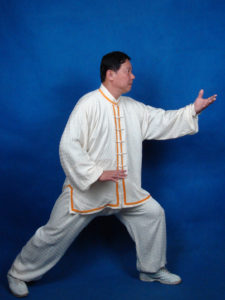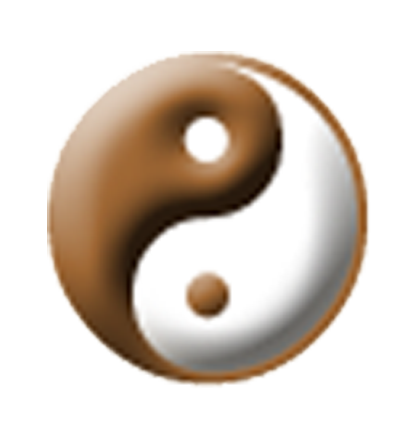08. Ward Off, Pull Down
Practice Method and Details
The following is from our book on Wudang Qigong, originally published in 1999. Photos of Professor Liu here are from 2006.

Set 8 Ward Off and Pull Down Exercise
Ward Off and Pull Down Exercise method is both straight and angular,
clean breath enters, corrupted breath leaves; regulate the breathing out and in.
Firm and soft join with each other, the breath connects with heaven,
whether amid waves or mountains, regard them as unimportant.
1) Preparation
The movement method is exactly the same as for Extreme Emptiness Exercise, Preparation Postures. (see Illustrations 1-1, 1-2, 1-3, 1-4)
2) Rise Fully, Lower Deeply
The previous movement pauses slightly, after regulating the breath out and in two times, both legs extend and straighten, naturally standing erect. At the same time, both arms revolve to the outside, both hands follow this turning inward and raising upward, the heels of the palms stop just below both breasts. (Illustration 8-1) The fingertips of both hands face front, the palms face up. At the same time as this, the dan tian sinks inward, breathe in. The tongue pushes against the upper palate, the teeth are slightly closed, the eyes look toward the front. (Illustrations 8-1 and 8-2)
The previous movement does not stop, the body’s center of gravity lowers, both legs bend at the knees squatting down and changing into a horse stance. At the same time, both arms revolve inward, both elbows close as if carrying something, the hands turn toward the front of the body in an arc shape and press down, stopping in front of the abdomen. The palms face down, the fingertips face forward. At the same time, the dan tian sticks outward, breathe out. The tongue is close to the lower palate, the teeth are lightly closed. The eyes look slightly downward, the intention is on the dan tian, the breath circulates through both the Du Mai and the Ren Mai. (Illustration 8-3)
3) Left Ward Off, Right Pull Down
The previous movement does not stop, the body’s center of gravity rises, the body turns left moving 45 degrees and naturally standing erect. The left arm revolves underneath, the left hand at the left front of the abdomen turns over, the palm faces down, the fingertips point right; the right hand rises up stopping in front of the left chest, the fingertips point left, the palm faces down. Both hands Lao Gong acupuncture points face each other, connected and attracting. At the same time as this, the dan tian sinks inward, breathe in. The tongue pushes against the upper palate, the teeth are slightly closed. The eyes look slightly downward, the intention is on the palms Lao Gong acupuncture points. (Illustration 8-4)
The previous movement pauses slightly, the body’s center of gravity moves to the right, the body continues turning to the left 45 degrees, the toes of the left foot lift up, the heel remains on the ground changing into a left high empty stance. At the same time as this, both hands resemble holding a ball in front of the body and yet moving. (Illustration 8-5)
Following closely behind the previous movement, there is no stop, the left foot turns slightly front, the whole sole of the foot touches the ground, the Yong Quan acupuncture point raises up, the left leg bends at the knee half squatting; the right leg bent knee extends straight changing into a left bow stance. At the same time, the left palm rises from in front of the abdomen, using the index finger to lead the breath in an arc shape toward the left front, warding off outward, at the same height as the shoulder. The index finger faces the left front, the palm faces up, the breath circulates through the hand’s Yang Ming Da Chang channel; the right hand from the front of the chest pulls down at an angle toward right and down, stopping at the right side of the abdomen beside the Shuidao acupuncture point, the breath circulates through the foot’s Yang Ming Wei channel. At the same time, the dan tian sticks outward, breathe out. The tongue is close to the lower palate, the teeth are lightly closed. The eyes look to the left front, the intention is on both hands’ index finger Shang Yang acupuncture points, both hands separate and pull apart as if pulling a silk thread. (Illustration 8-6)
4) Turn Right Combine the Breath
The previous movement pauses slightly, the body turns right 90 degrees. After regulating the breath in and out two times, both legs extend and straighten, naturally standing erect. At the same time, both arms revolve to the outside, both hands follow this turning inward and raising upward, the heels of the palms stop just below both breasts. The fingertips face front, the palms face up. At the same time as this, the dan tian sinks inward, breathe in. The tongue pushes against the upper palate, the teeth are slightly closed, the eyes look toward the front. (Illustration 8-7)
The previous movement does not stop, the body’s center of gravity lowers, both legs bend at the knees squatting down and changing into a horse stance. At the same time, both arms revolve inward, both elbows close as if carrying something, the hands turn toward the front of the body in an arc shape and press down, stopping in front of the abdomen. The palms face down, the fingertips face forward. At the same time, the dan tian sticks outward, breathe out. The tongue is close to the lower palate, the teeth are lightly closed. The eyes look slightly downward, the intention is on the dan tian, the breath circulates through both the Du Mai and the Ren Mai. (Illustration 8-8)
5) Right Ward Off, Left Pull Down
The movement methods are entirely the same as for Both Appear Left posture, but the left and right sides are reversed (see Illustrations 8-4, 8-5, and 8-6).
6) Return the Body Restoring Posture
The movement methods are entirely the same as for Pushing the Mountain Extremely Empty Initially (see Illustration 2-1). The previous movement does not stop, the movement methods are entirely the same as for Extreme Emptiness Exercise, Blend the Elements with One Breath (see Illustration 1-8).
Main Points and Functions
During practice it is important to pay attention in “ward off and pull down” to the path of the inner breath circulation, the main and collateral channels. First, because the intention moves, then the intention leads the breath following and traveling through the Dai Mai in both directions, the Chong Mai up and down, causing the breath and the blood to flow together. This movement opens and closes, raises yang and lowers yin. After both hands in front of the abdomen hold a ball, the index fingers pull and tug against each other. When sending out ward off, the shoulders relax, the elbows sink down, the wrist sits down, the arms round, the five fingers naturally separate, the index finger lifts outward, the other four fingers slightly close to the inside, the palm must be contained, the breath passes through the tips of the index fingers. When lowering with “pull down,” the wrist joint must sit down, the index finger remains raised up, the other four fingers grab downward very the same as grabbing a gourd in the water, the whole movement neither too close nor too distant, peaceful and yet not drifting.
When breathing in, to the best of one’s ability strive for not having sound, being continuous not broken, without form and without shape, cannot have stagnant, unsmooth, or gasping breath. In people, because breath is the foundation, then the mind is regarded as the root, and so the breathing is the master. Heaven cannot be without yin and yang, a person cannot be without breathing out and breathing in. One breath out and a hundred vessels all open; one breath in, a hundred vessels all close. Heaven and earth require yin and yang, true breath circulates, all cannot do without both breathing in and breathing out. When practicing, the breathing in and breathing out must certainly in all ways be natural, joined with the patterns for practicing. The method for regulating the breath is “come out lightly and enter slowly,” In breathing in and breathing out use the nose as the master. Employ this so strength is lively and the breath in order, when the mind is empty and the belly full, naturally practice will achieve perfection.
Practice Method:
Each time, practice 6 times or 12 times to make one set. Practicing again and again in succession is fine. The size of the movements, large or small, high or low is not restricted, but depends on the age or youth, the extent of physical strength, and the strength or weakness in the physique of the one who is practicing.
09/16/2022 Terri Morgan
